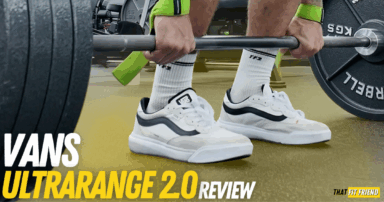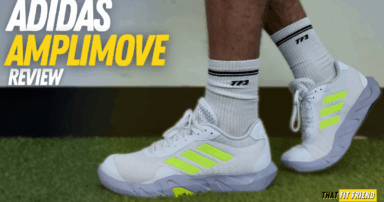In my coaching opinion, the dumbbell deadlift is an overlooked deadlift variation. This variation can be great for beginners, travel-focused hotel workouts, and lifters wanting to accrue more pulling volume, to name a few.
Unlike barbell deadlifts, the dumbbell deadlift will have a little more variability regarding their setup and how to perform them. Since dumbbell sizes vary, you’ll want to be strategic with your dumbbell deadlift form.
The dumbbell deadlift is an awesome deadlift variation for beginners and home workouts, and it can be easily programmed into circuit-style workouts. With dumbbell deadlifts, your setup and training goals are key to remember.
Dumbbell Deadlift Muscles Worked
The muscles worked with dumbbell deadlifts will depend on the variation you use. For example, if you’re using a traditional dumbbell deadlift setup rather than setting the dumbbells on an elevated surface, the muscles worked will change a bit.
Based on their setup, I often compare dumbbell deadlifts and the muscles they work to low-handle and high-handle trap bar deadlifts. The deeper knee and hip flexion used to achieve different positions will influence what you’re going to train.
When thinking about your goal and which muscles dumbbell deadlifts work, remember that the more you bend the knees, the more quad involvement you have. If your goal is focusing on or biasing the hamstrings and glutes, set the dumbbells up higher.
Dumbbell Deadlift Variations and Alternatives
There are a couple of awesome dumbbell deadlift variations that I regularly use and program. To be honest, I use the variations below more often than regular dumbbell deadlifts for both myself and my clients.
The reason I use the variations below is that I find that they help lifters get into positions we’re after easier than normal dumbbell deadlifts. For example, my issue with dumbbell deadlifts is that you have to work through a larger degree of knee and hip flexion to pick up the dumbbells.
This isn’t necessarily a bad thing, but when we consider the intent of deadlifts, they’re typically a more posterior muscle-dominant exercise used for building pulling strength.
So, I’ll usually set dumbbells on an elevated surface like a plate or use kettlebells to promote the body positions and mechanics we want, AKA a more hip-hinge dominant movement than a squat-like movement.
Traditional dumbbell deadlifts will put the body into a similar position as what the low-handle trap bar deadlift will. In both of these exercises, you’ll have more quad and adductor involvement and if you want a more posterior muscle bias, try the variations below.
1. Dumbbell Deadlift From a Plate
The dumbbell deadlift from a plate or similar elevated surface can be awesome for getting the body to try and replicate a somewhat similar position to a barbell deadlift. Note, I say similar because your hip and knee position will likely not be exactly the same as a barbell deadlift.
If you choose to perform this variation, you’ll follow the same steps as the “how to dumbbell deadlift” section above, but you’ll add a plate or two to manipulate the height from which you’re lifting.
For lifters that want a more glute and hamstring-focused dumbbell deadlift variation, set the dumbbells on a surface that puts their handles around mid-shin height. The higher you raise the surface, the more posterior muscle bias you’ll create.
2. Kettlebell Deadlift
The kettlebell deadlift is a great alternative to the dumbbell deadlift. This variation is similar to the elevated dumbbell deadlift because the kettlebell handles will allow you to maintain a higher hip position.
You can also place kettlebells on top of plates or a low box to increase the height of your hips to target the glutes and hamstrings a little bit more. Perform kettlebell deadlifts with a similar setup and form to traditional dumbbell deadlifts.
Dumbbell Deadlift Vs Barbell Deadlift
If you’re new to deadlifting, you may be wondering what the main differences between dumbbell and barbell deadlifts are. Both movements will have some carryover, but from a programming point of view, there are countless differences to note.
Difference 1: Dumbbell Deadlifts Will Be More Quad Dominant
The first difference between the dumbbell and barbell deadlift is the muscles they’ll work. In the dumbbell deadlift, you’ll have to bend down lower to reach the dumbbell handles and the dumbbells will sit to the side of the body.
This deeper knee bend will put a greater stretch on the quads, and since the hands are by the sides of the body, you won’t have to worry about “clearing” the knees, so your knees will naturally translate forward more with this variation.
This is why dumbbell deadlifts almost look squat-like with their movement pattern when they’re performed with the dumbbells sitting on the floor. Now, this isn’t to say that the barbell deadlift won’t hit the quads because it most certainly will.
In fact, learning how to leverage the quads more in the deadlift is a tip that I’m constantly helping lifters out with. The main difference, though, is that the quads won’t be stretched to the same degree as the dumbbell deadlift.
Difference 2: Barbell Deadlifts Will Be Better for Pulling Strength
If you’re brand new to deadlifts, then you can absolutely gain strength from dumbbell deadlifts. Intermediate lifters can also gain a strength benefit with dumbbell deadlifts when performed for higher rep sets that are often performed in circuits.
So please, don’t think you can’t gain strength with dumbbell deadlifts. In fact, dumbbell deadlifts can be awesome tools for building general lower body and pulling strength due to their setup.
However, when it comes to relative and top-end pulling strength, the barbell deadlift will often be the superior option. Barbell deadlifts can be loaded with heavier weights and most gyms will have a cap on the their dumbbell’s weight (most gyms stop at 100-110 lbs).
Frequently Asked Questions (FAQ)
Q:Are deadlifts with dumbbells effective?
Q:Why are dumbbell deadlifts so hard?
Q:Do dumbbell deadlifts work back?
Closing Remarks
The dumbbell deadlfit is a good exercise variation to learn for lifters from all walks of life. While it may not be your primary deadlift variation, it’s a good various to understand nonetheless.
For beginners, the dumbbell deadlift can be awesome for building general pulling strength, and for more advanced lifters, they can be a great conditioning tool and travel-friendly deadlift variation.
If you have additional questions about the dumbbell deadlift, drop a comment below or reach out to me personally via Instagram (@jake_boly or @that_fit_friend).



















Add a Comment